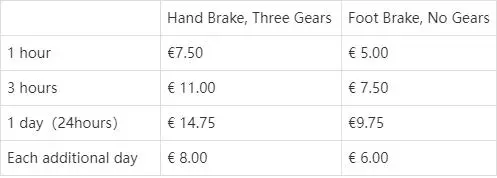2023年新高考I卷
第二部分 阅读(共两节,满分50分)
第一节(共15小题;每小题2.5分,满分37.5分)
阅读下列短文,从每题所给的A、B、C、D四个选项中选出最佳选项。
A
Bike Rental & Guided Tours
Welcome to Amsterdam, welcome to MacBike. You see much more from the seat of a bike! Cycling is the most economical, sustainable and fun way to explore the city, with its beautiful canals, parks, squares and countless lights. You can also bike along lovely landscapes outside of Amsterdam.
Why MacBike
MacBike has been around for almost 30 years and is the biggest bicycle rental company in Amsterdam. With over 2,500 bikes stored in our five rental shops at strategic locations, we make sure there is always a bike available for you. We offer the newest bicycles in a wide variety, including basic bikes with foot brake (刹车), bikes with hand brake and gears (排挡), bikes with child seats, and children’s bikes.
Prices

Guided City Tours
The 2.5-hour tour covers the Gooyer Windmill, the Skinny Bridge, the Rijksmuseum, Heineken Brewery and much more. The tour departs from Dam Square every hour on the hour, starting at 1:00 pm every day. You can buy your ticket in a MacBike shop or book online.
21. What is an advantage of MacBike?
A. It gives children a discount. B. It offers many types of bikes.
C. It organizes free cycle tours. D. It has over 2,500 rental shops.
22. How much do you pay for renting a bike with hand brake and three gears for two days?
A. €15.75. B. €19.50. C. €22.75. D. €29.50.
23. Where does the guided city tour start?
A. The Gooyer, Windmill. B. The Skinny Bridge.
C. Heineken Brewery. D. Dam Square.
答案解析:
21. B.
在Why MacBike部分中提到,MacBike拥有超过2500辆自行车,提供多种最新款式的自行车,包括基本款、带手刹和排挡的自行车、带儿童座椅的自行车和儿童自行车。因此,MacBike的一个优势是提供多种类型的自行车,选项B正确。
22. C.
根据Prices表格中的数据,带手刹和三个排挡的自行车的租金为每天€14.75,额外增加天数每天8欧元。因此租用两天的费用为€14.75+€8=€22.75,选项B为正确答案。
23. D.
在Guided City Tours部分中提到,“The tour departs from Dam Square every hour on the hour,starting at 1:00 pm every day.”,即导游城市游每天下午1点开始,每小时从Dam Square出发一次。因此,答案为D,即导游城市游从Dam Square开始。
B
When John Todd was a child, he loved to explore the woods around his house, observing how nature solved problems. A dirty stream, for example, often became clear after flowing through plants and along rocks where tiny creatures lived. When he got older, John started to wonder if this process could be used to clean up the messes people were making.
After studying agriculture, medicine, and fisheries in college, John went back to observing nature and asking questions. Why can certain plants trap harmful bacteria (细菌)? Which kinds of fish can eat cancer-causing chemicals? With the right combination of animals and plants, he figured, maybe he could clean up waste the way nature did. He decided to build what he would later call an eco-machine.
The task John set for himself was to remove harmful substances from some sludge (污泥). First, he constructed a series of clear fiberglass tanks connected to each other. Then he went around to local ponds and streams and brought back some plants and animals. He placed them in the tanks and waited. Little by little, these different kinds of life got used to one another and formed their own ecosystem. After a few weeks, John added the sludge.
He was amazed at the results. The plants and animals in the eco-machine took the sludge as food and began to eat it! within weeks, it had all been digested, and all that was left was pure water.
Over the years, John has taken on many big jobs. He developed a greenhouse-like facility that treated sewage (污水) from 1,600 homes in South Burlington. He also designed an eco-machine to clean canal water in Fuzhou, a city in southeast China.
“Ecological design” is the name John gives to what he does. “Life on Earth is kind of a box of spare parts for the inventor,” he says. “You put organisms in new relationships and observe what’s happening. Then you let these new systems develop their own ways to self-repair.”
24. What can we learn about John from the first two paragraphs?
A. He was fond of traveling. B. He enjoyed being alone.
C. He had an inquiring mind. D. He longed to be a doctor.
25. Why did John put the sludge into the tanks?
A. To feed the animals. B. To build an ecosystem.
C. To protect the plants. D. To test the eco-machine.
26. What is the author’s purpose in mentioning Fuzhou?
A. To review John’s research plans.
B. To show an application of John’s idea.
C. To compare John’s different jobs.
D. To erase doubts about John’s invention.
27. What is the basis for John’s work?
A. Nature can repair itself. B. Organisms need water to survive.
C. Life on Earth is diverse. D. Most tiny creatures live in groups.
答案解析:
24. 根据第一段"When John Todd was a child, he loved to explore the woods around his house, observing how nature solved problems."可知,John小时候喜欢探索周围的树林,并观察自然如何解决问题,这表明他具有好奇心和探究精神。因此选C。
25. 根据第四段"First, he constructed a series of clear fiberglass tanks connected to each other... After a few weeks, John added the sludge."可知,John建立了一系列的玻璃纤维罐,并在其中加入了污泥,这是为了测试他的生态机器是否能够清理有害物质。因此选D。
26. 提到福州是为了展示John的想法在一个实际项目中的应用。文中提到"He also designed an eco-machine to clean canal water in Fuzhou, a city in southeast China."这表明John的设计被应用到了实际中,用以清理福州的运河水。因此选B。
27. 根据最后一段“Ecological design” is the name John gives to what he does. “Life on Earth is kind of a box of spare parts for the inventor,” he says. “You put organisms in new relationships and observe what’s happening. Then you let these new systems develop their own ways to self-repair.”可知,John的工作基础是生命可以在新的关系中自我修复,这正是自然自我修复的能力。因此选A。
C
The goal of this book is to make the case for digital minimalism, including a detailed exploration of what it asks and why it works, and then to teach you how to adopt this philosophy if you decide it’s right for you.
To do so, I divided the book into two parts. In part one, I describe the philosophical foundations of digital minimalism, starting with an examination of the forces that are making so many people’s digital lives increasingly intolerable, before moving on to a detailed discussion of the digital minimalism philosophy.
Part one concludes by introducing my suggested method for adopting this philosophy: the digital declutter. This process requires you to step away from optional online activities for thirty days. At the end of the thirty days, you will then add back a small number of carefully chosen online activities that you believe will provide massive benefits to the things you value.
In the final chapter of part one, I’ll guide you through carrying out your own digital declutter. In doing so, I’ll draw on an experiment I ran in 2018 in which over 1,600 people agreed to perform a digital declutter. You’ll hear these participants’ stories and learn what strategies worked well for them, and what traps they encountered that you should avoid.
The second part of this book takes a closer look at some ideas that will help you cultivate (培养) a sustainable digital minimalism lifestyle. In these chapters, I examine issues such as the importance of solitude (独处) and the necessity of cultivating high-quality leisure to replace the time most now spend on mindless device use. Each chapter concludes with a collection of practices, which are designed to help you act on the big ideas of the chapter. You can view these practices as a toolbox meant to aid your efforts to build a minimalist lifestyle that works for your particular circumstances.
28. What is the book aimed at?
A. Teaching critical thinking skills.
B. Advocating a simple digital lifestyle.
C. Solving philosophical problems.
D. Promoting the use of a digital device.
29. What does the underlined word “declutter” in paragraph 3 mean?
A. Clear-up. B. Add-on. C. Check-in. D. Take-over.
30. What is presented in the final chapter of part one?
A. Theoretical models. B. Statistical methods.
C. practical examples. D. historical analyses.
31. What does the author suggest readers do with the practices offered in part two?
A. Use them as needed. B. recommend them to friends.
C. Evaluate their effects. D. Identify the ideas behind them.
答案解析:
28. 根据第一段"The goal of this book is to make the case for digital minimalism..."可知,这本书的目标是提倡数字极简主义,即一种简单的数字生活方式。因此选B。
29. 根据第三段"This process requires you to step away from optional online activities for thirty days..."可知,"declutter"这个过程要求读者暂时远离可选的在线活动,并在30天后有选择地恢复一些活动,这意味着这个词的意思是清理或简化。因此选A。
30. 根据第四段"In doing so, I’ll draw on an experiment I ran in 2018 in which over 1,600 people agreed to perform a digital declutter. You’ll hear these participants’ stories and learn what strategies worked well for them, and what traps they encountered that you should avoid."可知,最后一章提供了2018年的一项实验,其中1600多人同意进行数字清理,并分享了他们的故事和策略,这些都是实际的例子。因此选C。
31. 根据最后一段"Each chapter concludes with a collection of practices, which are designed to help you act on the big ideas of the chapter. You can view these practices as a toolbox meant to aid your efforts to build a minimalist lifestyle that works for your particular circumstances."可知,作者建议读者将这些实践视为工具箱,根据个人情况需要时使用它们来构建适合自己的极简生活方式。因此选A。
D
On March 7, 1907, the English statistician Francis Galton published a paper which illustrated what has come to be known as the “wisdom of crowds” effect. The experiment of estimation he conducted showed that in some cases, the average of a large number of independent estimates could be quite accurate.
This effect capitalizes on the fact that when people make errors, those errors aren’t always the same. Some people will tend to overestimate, and some to underestimate. When enough of these errors are averaged together, they cancel each other out, resulting in a more accurate estimate. If people are similar and tend to make the same errors, then their errors won’t cancel each other out. In more technical terms, the wisdom of crowds requires that people’s estimates be independent. If for whatever reasons, people’s errors become correlated or dependent, the accuracy of the estimate will go down.
But a new study led by Joaquin Navajas offered an interesting twist (转折) on this classic phenomenon. The key finding of the study was that when crowds were further divided into smaller groups that were allowed to have a discussion, the averages from these groups were more accurate than those from an equal number of independent individuals. For instance, the average obtained from the estimates of four discussion groups of five was significantly more accurate than the average obtained from 20 independent individuals.
In a follow-up study with 100 university students, the researchers tried to get a better sense of what the group members actually did in their discussion. Did they tend to go with those most confident about their estimates? Did they follow those least willing to change their minds? This happened some of the time, but it wasn’t the dominant response. Most frequently, the groups reported that they “shared arguments and reasoned together.” Somehow, these arguments and reasoning resulted in a global reduction in error. Although the studies led by Navajas have limitations and many questions remain, the potential implications for group discussion and decision-making are enormous.
32. What is paragraph 2 of the text mainly about?
A. The methods of estimation.
B. The underlying logic of the effect.
C. The causes of people’s errors.
D. The design of Galton’s experiment.
33. Navajas’ study found that the average accuracy could increase even if
________.
A. the crowds were relatively small
B. there were occasional underestimates
C. individuals did not communicate
D. estimates were not fully independent
34. What did the follow-up study focus on?
A. The size of the groups.
B. The dominant members.
C. The discussion process.
D. The individual estimates.
35. What is the author’s attitude toward Navajas’ studies?
A. Unclear. B. Dismissive.
C. Doubtful. D. Approving.
答案解析:
32. 第二段主要讲述了群体智慧效应背后的逻辑,即人们的错误不是总是相同的,一些人倾向于高估,而另一些人倾向于低估,当这些错误平均在一起时,它们会相互抵消,从而得出更准确的估计。因此选B。
33.第三段提到,当人群被进一步分成允许讨论的小组时,这些小组的平均值比相同数量的独立个体的平均值更准确。这表明即使估计不是完全独立的,平均准确性也可以提高。因此,答案是D。
34. 根据第四段"In a follow-up study with 100 university students, the researchers tried to get a better sense of what the group members actually did in their discussion."可知,后续研究关注的是小组讨论过程中成员们实际做了什么。因此选C。
35. 根据最后一段"Although the studies led by Navajas have limitations and many questions remain, the potential implications for group discussion and decision-making are enormous."可知,尽管Navajas的研究存在局限性,还有很多问题待解答,但作者认为这些研究对于群体讨论和决策制定的潜在影响是巨大的。这表明作者对Navajas的研究是持认可态度的。因此选D。








